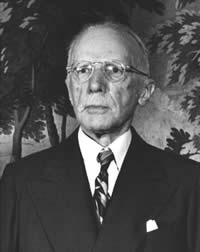 William G. Mather's Story
William G. Mather's Story
Much of the following material comes from Timothy J. Loya's article, "William Gwinn Mather, The Man," Inland Seas, Vol. 46, No. 2, Summer 1990. Several copies of this particular Inland Seas issue are in the ship's library. Another relevant book is Robert Wiebe's The Search for Order: 1877-1920.William Gwinn Mather, the man behind the ship and Cleveland-Cliffs Iron Company, was both a shaper of his world and shaped by the world around him.
William G. Mather graduated from college and began working for his father's company in a time when the seeds of the Progressive Era were being sown. This era began in Germany during the 1860s and 1870s. New forms of education were underway, especially in the area of earning a Ph.D. Many American scholars went to Germany to study under the new masters and then returned to teach in American universities. This movement took root in Germany and then spread to the US.
When William G. Mather attended Trinity College in Connecticut, this influence was prevalent on the East Coast. Mather was likely under the tutelage of some returning professors, full of new ideas on college education. He was in a prime position to assimilate the new trends in education and new outlooks on the world.
As William G. Mather expanded his father's business, it merged vertically in 1890 to form the Cleveland-Cliffs Iron Company. The new company already had a fleet, but didn't possess a strong commitment to developing a large fleet until just after the turn of the century. This horizontal structuring continued into 1929 when Cleveland-Cliffs helped found Republic Steel Corporation, not just by agreeing to carry their ore, but also by owning a large quantity of shares in this newly merged corporation.
In the Progressive Era, an important aspect to many wealthy businessmen's careers was philanthropy. Many of these men believed, as did Mr. Mather, that they held their wealth in a public trust for the public, much like a museum holds artifacts in the public trust for the public's education. Therefore, these business leaders had a tendency to give back to the community around them. They gave money to found and fund libraries, art museums, theaters, and benevolent societies. They also provided benefits and training programs within their individual businesses. Life may not have been all that good for a miner, or for a coalpasser, nor any other Cliffs subordinates. But if you worked for one of these large conglomerates at this time, you were taken care of.
Owners saw their company employees as family. Family was an important factor in a Progressive Era magnate's life, and these men felt obligated to take care of their families. Surprising to us is the fact that benefits were given to employees without government pressure and mandates. (Only after the Great Depression did the public begin to look to the US government for this care; and hence the government began to put pressures on big business to do more.)
This is the world in a nutshell that William G. Mather helped to create. He was influenced during a formative period prior to 1890; then he became a leader in the Progressive Era. He saw his company as family, and he gave much back to the community.
We have several pictures of Mr. Mather. Take a look at them. His face and eyes show confidence. He embodies the strength of character and self-confidence that characterizes the Progressive Era man.
For further information on William G. Mather, the man, read "William Gwinn Mather, The Man" in the William G. Mather Commemorative Edition of The Inland Seas; Quarterly Journal of the Great Lakes Historical Society, Volume 46, Number 2; Summer 1990. (Copies are available in the Docent Lounge and Mather Ship Shop.